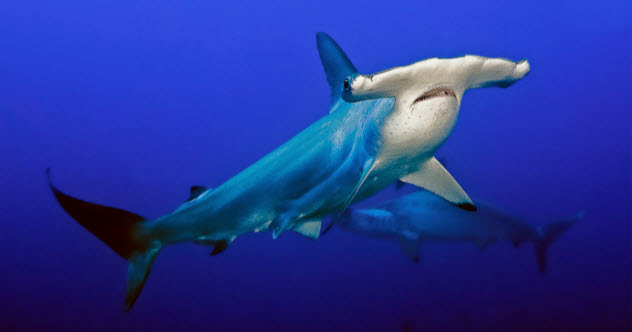 Technology
Technology  Technology
Technology  Humans
Humans 10 Everyday Human Behaviors That Are Actually Survival Instincts
 Animals
Animals 10 Animals That Humiliated and Harmed Historical Leaders
 History
History 10 Most Influential Protests in Modern History
 Creepy
Creepy 10 More Representations of Death from Myth, Legend, and Folktale
 Technology
Technology 10 Scientific Breakthroughs of 2025 That’ll Change Everything
 Our World
Our World 10 Ways Icelandic Culture Makes Other Countries Look Boring
 Misconceptions
Misconceptions 10 Common Misconceptions About the Victorian Era
 Mysteries
Mysteries 10 Strange Unexplained Mysteries of 2025
 Miscellaneous
Miscellaneous 10 of History’s Most Bell-Ringing Finishing Moves
 Technology
Technology Top 10 Everyday Tech Buzzwords That Hide a Darker Past
 Humans
Humans 10 Everyday Human Behaviors That Are Actually Survival Instincts
 Animals
Animals 10 Animals That Humiliated and Harmed Historical Leaders
Who's Behind Listverse?

Jamie Frater
Head Editor
Jamie founded Listverse due to an insatiable desire to share fascinating, obscure, and bizarre facts. He has been a guest speaker on numerous national radio and television stations and is a five time published author.
More About Us History
History 10 Most Influential Protests in Modern History
 Creepy
Creepy 10 More Representations of Death from Myth, Legend, and Folktale
 Technology
Technology 10 Scientific Breakthroughs of 2025 That’ll Change Everything
 Our World
Our World 10 Ways Icelandic Culture Makes Other Countries Look Boring
 Misconceptions
Misconceptions 10 Common Misconceptions About the Victorian Era
 Mysteries
Mysteries 10 Strange Unexplained Mysteries of 2025
 Miscellaneous
Miscellaneous 10 of History’s Most Bell-Ringing Finishing Moves
10 Facts That Will Change How You View Sharks
Since the movie Jaws hit theaters decades ago, many people have viewed sharks as nothing more than harbingers of watery death and destruction. While it’s true that great whites can be dangerous to humans, the large majority of shark species have never attacked humans, unprovoked or otherwise.
In fact, while we’ve been led to believe that sharks are the most dangerous thing you can find in the water, they’re not on the top of the food chain in our world’s oceans. The tale of the shark has been greatly misunderstood and exaggerated over the years, but the real facts are even more interesting than the myths.
10Some Sharks Are Bottom-Feeders
Most people think of sharks as dangerous, bloodthirsty predators that won’t stop until everything in the ocean is gobbled up. However, with at least 400 currently known shark species, you may be surprised to learn that many of them don’t even pose that much of a threat to small fish. Sharks definitely aren’t a major threat to humans because we’re not their natural prey. When a shark attacks a human, the animal is often far outside of its normal comfort zone and has made a mistake.
Many species of shark are actually bottom-feeders, so they aren’t really a threat to humans, even in a purely accidental situation. There are also sharks that use different methods of filter feeding for their nutritional needs. The whale shark, basking shark, and megamouth shark all use various forms of filter feeding in which they strain plankton for food.
For even the largest sharks, dolphins can be the most dangerous food source to attack. Dolphins like to travel together and have been known to work as a unit to fend off shark attacks. Also, dolphins are hardly the helpless, friendly creatures of the deep that we so often believe them to be. Recent research has shown that they like to form gangs, steal fertile females from other dolphin groups, and even rape other males as a show of dominance.
9Some Sharks Can Stop Swimming
For a long time, we believed that if a shark stopped swimming, it would be unable to breathe and quickly drown in the water. However, the truth is actually more complicated. Depending upon how they breathe, some sharks can stop swimming.
Most sharks use a form of breathing, called “ram ventilation,” in which they force water through their lungs using swift, forward movements. However, some sharks use a more ancient breathing method, called “buccal pumping,” which can be used while the shark is at rest. This method allows the shark to use its mouth muscles to draw in water so that it can breathe. There are also sharks known as “obligate ram ventilators” that can’t breathe using buccal pumping. These are the sharks that supposedly die if they stop swimming. However, scientists have occasionally observed obligate ram ventilators in a resting mode, and they definitely aren’t drowning.
The practice of shark finning—where a shark is caught, its fin is cut off for shark fin soup, and the shark is tossed back into the water—makes the subject of sharks drowning even more complicated. While it seems that removing a fin would be certain death, some of these finned sharks have been caught alive (though in a starved state) in shark-catching competitions. Clearly, scientists have more to learn about how sharks breathe.
8Shark Attacks Are Increasing But Still Overhyped
According to the media, shark attacks have increased in 2015, especially off the coasts of North and South Carolina. Normally, there are only six attacks a year in that area, but there have already been 11 as of early August 2015. Although some in the media have likened this to a feeding frenzy, George H. Burgess, who heads the International Shark Attack File, wrote an op-ed for CNN explaining why the shark attacks are increasing and why we shouldn’t be that worried.
First of all, Burgess assures us that the actual odds of being attacked by a shark are still roughly 1 in 11.5 million. He also points out that you have a better chance of being killed by a lightning strike than a shark attack.
More importantly, from his extensive study as the director of the Florida Program for Shark Research at the Florida Museum of Natural History, Burgess believes that overall shark attacks are actually decreasing on a percentage basis. The problem, he says, is that the number of people going to the beach has increased greatly. So even if the percentage of shark attacks declines, the number of people attacked is increasing simply because there are more people in the water.
Also, drought conditions caused by changes in the environment can alter the mix of salt water and freshwater, bringing sharks closer to shore than normal. However, Burgess maintains that even this danger can be reduced with simple common sense. He suggests avoiding the water at dawn and dusk when sharks are most active, swimming in groups, and paying attention to your surroundings.
7Sharks Are Not The Most Dangerous Predator In The Ocean
For most people who grew up watching movies like Jaws or Sharknado, large sharks, such as the great white shark, are often seen as the apex predators of the ocean. No one usually thinks of a shark as prey. However, dolphins have long vied with sharks for supremacy in the ocean. Although a regular dolphin is no match for a great white shark, there is one species of dolphin that can make just about anything in the water swim for cover as fast as it can.
That creature is the orca, sometimes known as a “killer whale,” even though it’s definitely a member of the dolphin family. By taking advantage of an evolutionary weakness in sharks, orcas have hunted, killed, and eaten large sharks like mako and great white sharks.
The orca does this in one of two ways. Using its tail, the orca can create currents to force the shark to the surface and then hit it with a tail slam. Otherwise, a group of orcas can corral the shark and take turns attacking, often going for the belly. Eventually, the orcas will turn the shark upside down, causing the shark to enter into a state known as “tonic immobility.” The shark completely stops fighting, and the orcas now have an easy meal. Scientists aren’t sure how well the orcas understand tonic immobility, but they clearly understand it well enough to hunt down and eat great white sharks.
6Stressed Females Can Reproduce Without A Male

Usually occurring only in snakes and lizards, parthenogenesis is a special type of reproduction in which a baby animal hatches from an unfertilized egg without using any male DNA. Recently, researchers were amazed when a female hammerhead shark had a baby hammerhead, despite the mother having no contact with a male hammerhead during her three years of captivity at a Nebraska aquarium. Although females can hold sperm, none have been known to hold it nearly that long.
After a detailed analysis of the baby—which was killed by another fish shortly after birth—the scientists concluded that the baby must have been conceived through parthenogenesis because it had no male DNA. This was a huge breakthrough in research because no one had believed that a shark was capable of such a feat.
Shortly afterward, an aquarium in Detroit reported similar incidents with their bamboo sharks. Although we’re not sure yet if parthenogenesis occurred with these sharks, it seems a likely explanation. This could mean that many shark species are capable of reproducing without male DNA.
The researchers believe that parthenogenesis occurs only in extreme situations, such as enforced captivity, in which the animal can’t find another way to get a mate. While this could give sharks a certain evolutionary advantage if their numbers continue to decline, it does have a serious disadvantage. Parthenogenesis reduces genetic diversity, which is detrimental to the long-term health of a species.
5Sharks Are A Threatened Species
We’ve already talked about shark finning and its use to create shark fin soup, which is incredibly popular in certain parts of Asia. Often used for special occasions, such as celebrating a successful business deal, shark fin soup is an expensive status symbol. According to chef and restaurateur Gordon Ramsay, the shark fin “tastes of nothing.” Instead, it’s used almost entirely for texture. Shark fin soup has become a cultural tradition, making its popularity hard to eradicate.
Those who farm for shark fins capture the shark, saw off the fin, and toss the rest of the live shark back into the water to slowly die. Although this is ultimately a death sentence for the shark, it’s also incredibly wasteful because the rest of the shark could have been used for something. Many sharks also die when they get caught in nets meant for other fish.
A number of shark species are already facing extinction, with experts believing the future of world shark populations may be in jeopardy. While some people may find it hard to sympathize with sharks, they’re an important part of our ecosystem. Their absence would negatively affect us in many different ways. Many conservation groups are racing to protect sharks before they’re gone for good, but the outcome is uncertain at this time.
4Fake Shark Cures For Cancer
You may have heard claims that sharks don’t get cancer or that you can cure cancer by eating shark cartilage. Even if sharks were better protected against cancer than humans, it doesn’t make sense that the shark’s protective mechanism would be transferred to humans simply by ingesting its cartilage. However, there is both limited truth and some myth to these claims.
Some research suggests that certain sharks have a chemical called “squalamine” that’s naturally good at fighting cancer. According to the results of these clinical studies, certain extracts from shark cartilage, when strategically injected by doctors, may be helpful in battling tumors. However, other scientists have argued that current research shows that sharks are no better at fighting cancer than cows or any other animals.
Although cancer is rarely seen in sharks, Dr. Gary Ostrander, a biology professor at Johns Hopkins in 2003, cautioned even then that we shouldn’t jump to the conclusion that most or all sharks are resistant to cancer. It’s difficult to study them in sufficient numbers to be sure how likely they are to get cancer. Also, a sick shark probably won’t find its way to a researcher. It’s more likely to become a meal for another fish. Furthermore, scientists have found malignant tumors in sharks, including in their cartilage.
In any case, taking shark cartilage orally would never be effective at fighting cancer in humans because the delivery method would neither get it to the bloodstream nor properly target specific tumors.
3The Dangerous Unseen Consequences Of Cage Diving
After movies like Jaws, an enormous industry sprang up to cater to individuals who wanted to experience the fear of facing a shark in the real world, although they wanted to do it safely. Currently, there are businesses throughout the world that offer cage diving so that tourists can see sharks up close.
With cage diving, a tourist goes out on a boat, suits up, and descends into a cage to stay safe while underwater. The operator of the tour boat then lures a shark to the cage so that the people inside can get a thrill out of almost being eaten. Unfortunately, they’re also baiting sharks into waters that are closer to where humans live, making the sharks interested in human flesh, and getting them acclimated to the presence of human boats. Many people in Australia, where this is a popular practice, are concerned that it’s changing the behavior of sharks and making them more familiar with and aggressive toward humans.
On the other hand, tour operators want to expand into new areas to keep their businesses profitable. They claim that orca attacks have caused sharks to vacate—sometimes for months at a time—the areas where the operators make their money. This topic has become quite controversial. Before operations are expanded, many people want to see more studies done on the behavioral effects of cage diving on sharks.
2Sacrificing People To The Shark Gods

In ancient times, some people revered sharks, actually viewing them as gods. In both Hawaii and India, worship of shark gods was observed, sometimes involving human sacrifice to secure all the usual good things that praying and sacrificing are supposed to provide. In Hawaii, many of these gods had names, such as the ancient shark god Kauhuhu.
Surprisingly, many of these shark-related sacrifices were not forced but instead entered into willingly by followers who waded into the ocean to meet their maker. This was true for cultures on multiple continents. In some of the stories, people are described as being in a state of religious ecstasy as they sacrifice themselves to the gods. In one tale, the sharks were so used to coming to these waters to eat the people running to meet them that a mere shadow was enough to draw the sharks’ attention, and the waters would quickly turn red with blood.
1Rendering A Shark Completely Helpless Without Tools
As mentioned earlier, orcas sometimes hunt large sharks, exploiting a defense mechanism called “tonic immobility” to increase their chances of success. Divers and other experts have also taken advantage of tonic immobility to better ensure everyone’s safety when studying and interacting with sharks. If you can get the shark to turn upside down and then hold it underwater, the animal will remain immobile for several minutes at a time.
Tonic immobility is an evolutionary defense mechanism of the shark, similar to playing dead. However, scientists are baffled as to why a creature which is at or near the top of the food chain would develop such a defense mechanism. Threats to sharks from humans and orcas are too recent to have played a part. One theory is that tonic immobility in sharks may be related to mating, but there is not yet enough evidence or testing to know if this is true.
Nevertheless, orcas seem to have recently discovered this weakness in sharks and are now exploiting it happily. Sharks may not be as much of a threat as people realize, but the orca—the true apex predator of the ocean—is getting smarter all the time.








